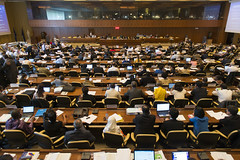ILO is a specialized agency of the United Nations


| Français - Español | |
| |
|
| > Homepage > Online information resources > Resource guides > History of the ILO | |
|
ILO activities in the post-war world (Part 1: 1946-1959)
|
Launch of the Special Migration ProgrammeUnder its Constitution,
one aspect of ILO’s mission is to protect migrant workers: “to further
among the nations of the world programmes which will achieve […] the
provision, […] under adequate guarantees for all concerned, of facilities
for training and the transfer of labour, including migration for employment
and settlement” (Annex to the Constitution: Declaration concerning the aims
and purposes of the International Labour Organization). The Preliminary Conference on Migration was held in Geneva from 25 April to 9 May 1950 pursuant to the decision taken at the 110th Session (January 1950) of the ILO Governing Body. The Conference constituted a starting point for international activities in this field (see Key documents, “International Migration 1945-1957”, p. 291). Indeed, the Member States of the Organization for European Economic Co-operation (OEEC) and ILO, expressing their satisfaction at the work accomplished by the Preliminary Conference, decided to make available to ILO a fund amounting to nearly one million dollars so as to enable it to develop practical activities and furnish advice and opinions on migration issues to the governments requesting them (see Key documents, “Migration and Economic Development”, pp. 114-115). The Special Migration Programme was launched in June 1950, its aim being to facilitate and organize the flow of migrants between European countries with excess manpower and countries overseas seeking manpower with a view to their economic development. Thus, as of the 1950s ILO action was expanded to encompass all aspects pertaining to migrant workers and their families, for whom it defined international standards, spread information and dispensed technical assistance. The Organization dealt with emigration, immigration, organization of the employment market and the vocational training of candidates for emigration. It provided assistance through the expert missions set up in Bonn, Rome and Vienna and through a group of experts established within the Action Centre opened in Latin America. Protection of trade union rights“Following the adoption of the Freedom of Association and Protection of the Right to Organize Convention, 1948 (No. 87), and the Right to Organize and Collective Bargaining Convention, 1949 (No. 98), the ILO, in agreement with the Economic and Social Council of
the United Nations (ECOSOC), established a procedure for the examination of
allegations concerning the infringement of trade union rights, including a
new supervisory body: the Fact-Finding and Conciliation Commission on
Freedom of Association. […] In view
of the fact that the principle of freedom of association was enshrined in
the ILO Constitution and the Philadelphia Declaration, as well as its importance for the tripartite structure of
the ILO, allegations concerning infringements of trade union rights could
be made against all ILO member States, whether or not they had ratified the
relevant Conventions. On the other hand, no allegations could be referred
to the Fact-Finding and Conciliation Commission on Freedom of Association
without the consent of the government concerned. It was emphasized that the
new arrangements would not in any way replace the existing constitutional
provisions concerning representations and complaints.” (Improvements in the standards-related activities of the ILO, (pdf 446 KB), p.13)
In November 1951, at its 117th Session, the ILO Governing Body took another step forward by establishing the Committee on Freedom of Association. “The examination of allegations by the [Committee on Freedom of Association], unlike the Fact-Finding and Conciliation Commission, did not require the consent of the government concerned. The [Committee] rapidly became the main body responsible for examining allegations of violations of freedom of association” (see Improvements in the standards-related activities of the ILO, p. 13). |
|
| Last update: 23.02.2015 | ^ top |











